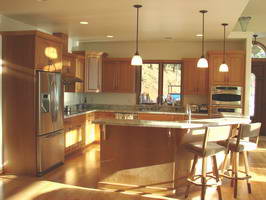Outdoor Lighting For The Home
 '; ';
|
Wire or cable type normally used here to feed such an outside light or if it would be ok in electrical plastic or metal conduit… © By: Dave Rongey |
Considerations For Outdoor Lighting
Question: Hi Dave.
I was an electrician in the UK. Retired now. The system here is a lot different than there but the basics have to be the same.
We have an outside standard fitting about 5 ft tall with 3 lights, enclosed.
I have no idea of the wire or cable type normally used here to feed such an outside light or if it would be ok in electrical plastic or metal conduit. In the UK in tube it would be heavy gauge galvanized and screwed stuff. Or a certain armored cable protected with a trench and ceramic cover. Or pyro/BICC.
To make it easy I was thinking of using low voltage- say 12 to 50 VAC.
I don’t expect there will be any lamp or bulbs with the same Edison Screw size as the normal 120 volt bulbs as that is inviting trouble. I did notice though that there are still the old style fuses that are E Based and it would be possible to use three of these and solder a fitting for say a 50 volt bulb.
I’d need a transformer at about 120Watt (VA I guess is more correct!) at around 2.5 amp to supply the proposed 3 x 40 watt bulbs.
Any suggestions?
Dave: Yes, it is best just to purchase a outdoor lighting kit. These kits come with the transformer power supply, wire cable, the light fixtures and light bulbs. I have produced a great guide the will assist you with these decisions.
Light Up Your Home for Beauty, Safety and Security!
You may also consider solar powered lighting lighting fixtures.
Solar Lights – for Energy Savings and Practicality!
Also as a matter of interest in the average street, what is the voltage of the HV line before its transformed to 120 volts?
Dave: 12KV is most common, in some areas 4160Volts.
And at the main board or mains for the consumer Unit, is the Earth Ground connected to the Neutral?
Dave: Yes, at the Main the Ground and Neutral is bonded.
It looks to be. There is no Ground wire as such, is there coming in from the TX on the pole? Seems to be a nsplit single phase center tapped to give 120 to center and 240 across the outers. The center being made the ‘cool’ or neutral wire ( and Ground?) and the other two the hot or live.
Thanks.
Dennis.
This electrical question came from: Dennis, a Electrician from Moses Lake, WA
Additional Comments: It’s brilliant!
Dave’s Reply: As you can see, this was a very lengthy and informative question so I have inserted my responses above, however I have provided some links below for additional information. Thanks for your electrical question Dennis.
The Following links will assist you with your electrical question:
Electrical Calculations and Formulas
electrical wire
Electrical Wire for the Home
Complete listing of electrical wire types and parts used for home projects with electrical code information serves as selection guidelines.
For more information about Circuit Wiring
Circuit Wiring
Electrical Circuit Wiring
This article looks at common 120 volt and 240 volt house wiring circuits and the circuit breakers that are installed identifying the types and amperage sizes used in most homes.
The following may also be helpful for you:
|
|
Be Careful and Be Safe - Never Work on Energized Circuits!
Consult your Local Building Department about Permits and Inspections for all Electric Wiring Projects.
More articles about Lighting, Outdoor Lighting and Home Electrical Wiring: |
|
| « Previous | Next » |
Sauna Heater Electrical GFI Receptacle |
House Electrical Rewiring Methods and Practices |















